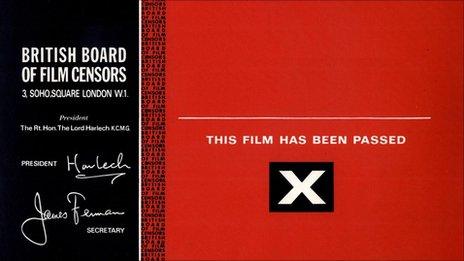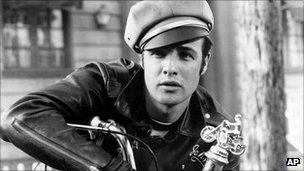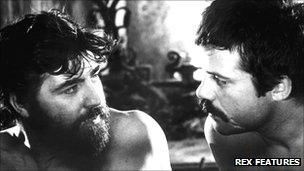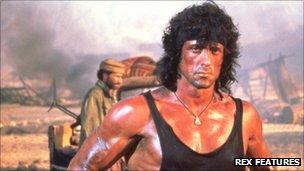Banned movies: The films that vexed the censor
- Published
- comments

The way films are censored can tell us much about changing attitudes in society to sex, violence and rebellion, writes Ben Southwell.
Enter the hidden world of the British Board of Film Classification's written archive and a hundred years of film censorship are laid bare.
It's possible to chart the changing concerns of the board as it has trodden a fine line between enforcing the standards of the day and recognising artistic endeavour.
The letters between censor and film-makers begin to take on a life of their own as the relationship develops from regulator to collaborator and beyond.
An examiner's report on Ken Russell's The Devils reveals a wry sense of humour often present in the censor's letters. "I have no personal knowledge as to the shape of nuns under their habits, but I doubt they all look like the 'Playmates' of this film."
What the letters reveal is the way certain films and scenes can be singled out to show the changing values of a nation. In the post-war years it was fears of social unrest that were near the top of the agenda.
As the nation relaxed into the 1960s, nudity becomes a prime concern. The early 1970s saw film-makers keen to push at the limits of acceptability.
In the 1980s the board changed its name from British Board of Film Censors to that of Film Classification and it was levels of violence that capture the attention.
Viewed from 2011, many of the board's decisions seem odd, quaint even, and we are able to see many of the scenes originally deemed unacceptable on DVD reissues.
But in their day these were ground-breaking films, pushing the boundaries of propriety. At times it seemed that all that stood between the nation and chaos, was the censor.
The Wild One - social unrest

The Wild One was banned for 14 years. Now it's a PG
"What are you rebelling against, Johnny?"
"What have you got?"
Marlon Brando's The Wild One was submitted to the board in 1953. This story of a motorbike gang terrorising a small town in America was banned amid fears of what it might lead to in the UK.
The examiner's report sums up the concerns of the board very succinctly. "Brando is attractive, admirable, imitable."
That represented a significant problem to a Britain still governed by a rigid social order. The board had no option but to come to the conclusion that: "We are unable to issue a certificate for this spectacle of unbridled hooliganism." The film was banned.
The film-makers pleaded with the censor to think again.
As they said: "It is terrible that a costly picture of this description will have to be placed on the shelf without a pennyworth of revenue accruing from this territory."
But the censor was unmoved and immovable. The film remained banned for 14 years.
By the time it was finally granted a certificate in the late 1960s the world had moved on to such an extent that it was almost impossible to see what all the fuss had been about. Today the film carries a child-friendly PG certificate.
Garden of Eden - nudity
As Britain emerged from the austerity of the post-war years, long-held values came under pressure. The censor had long had a very strict approach to the portrayal of nudity on screen. By the 1950s a rather curious type of film had begun to challenge this ban.
Described as "naturist" films, these titles were deemed to be "educational". Typical of them was Garden of Eden ("filmed in a real naturist park!").
The examiner's report once more portrayed a singular sense of humour: "I think Garden of Eden would provoke very noisy reactions at tough cinemas like The Elephant. There are some unconsciously funny nudes. Especially one young lady with peculiar glutial muscles."
But the board could not let this sort of thing past. "The question of precedent must be the over-riding one here."
However, the board's decision was only ever advisory. Local councils could choose to allow these films to be shown, a choice more and more of them began to make.
By the late 1950s, the board seemed more like Canute than the moral guardian of the nation. In 1958 the censor bowed to the inevitable.
"This film was recently reconsidered by this board and it was decided to rescind the previous decision and to pass the film with an A-certificate." The floodgates were opened.
Women in Love - male nudity

Women in Love's nude male wrestling caused eyebrows to flutter
1969 was another watershed moment as full-frontal male nudity in Ken Russell's film Women in Love was passed by the censor.
The letters between censor and producer/writer Larry Kramer reveal a relationship where the examiner has almost become part of the creative process. This was a time when many creative arts were perceived to be at a peak and the censor seems to have shared a sense of the possibilities offered by cinema.
Kramer sent the script to the board before filming commenced to hear their opinion. "We would very much like to lunch with you after you have read the script," he wrote. "We feel we are embarking on an extraordinary creative experience which we would like to have you share with us."
The censor replied: "Dear Larry, this seems an exciting production. I know Ken Russell and his work well and I am very happy that he is going to do this picture with you."
However, the censor was still concerned over the scene in which the two male protagonists wrestled in the nude. "If they were just indulging in horseplay as two friends there would not be problems, but we have already had clear indications that there are homosexual feelings between them, and this kind of scene could be troublesome if not handled discreetly. I can only advise you to be very cautious about it."
When the film was submitted for certification this was the board's response: "While we are prepared to accept the wrestling scene, we would like you to remove if possible full-length shots in which genitals are clearly visible."
Ken Russell was willing to co-operate and collaborate: "I gather there is one full-length shot of Gerald which gives offence. The only way out of this... is to darken the shot and this I would be quite prepared to do." He finished his letter with a typical flourish: "Throwing myself on your good judgement, Ken Russell."
As the darkened prints received the go-ahead the mutual respect of censor and film-maker reflected the mood of the age. The censor wrote to the film-maker: "We all think it's a brilliant film and are taking this into account in our judgement of it."
This moved the film-maker to reply: "Dear John, can I say how grateful Ken and I are for your understanding help throughout these past months."
Rambo III - violence

The censors thought there was a lot of shooting in Rambo III
When Rambo III was submitted to the board in the late 80s two previous Rambo films had each received the 15 certificate. But between parts two and three, the Hungerford massacre - when Michael Ryan killed 16 people with an assortment of guns - had made firearms and violence front-page news in Britain.
The attitude of what was now the British Board of Film Classification showed the way it had always had to respond to shifts in public opinion.
As a result of events in Hungerford, as one examiner wrote: "This silly, rather enjoyable movie is likely to be a political red-hot potato."
The problem was that Rambo III seemed to be almost non-stop gunfire. "It's not so much what is shown, but how much and how relentlessly."
The examiners fell into an intense debate over whether to grant the film the same 15 certificate as its predecessors (albeit with cuts), or the more adult 18 reflecting the heightened sensitivities around gun use.
"Public disquiet is at a height. It is naive to believe that we can always act without regard to political realities. Indeed I would go further and argue that it's irresponsible." The film was released with an 18 certificate after cuts.
The board have imposed a rolling 20-year embargo on the written archives.
Correspondence over notorious films like Natural Born Killers or Reservoir Dogs remains under lock and key, but the archive revealed so far shows an ever-changing attitude to the things that have concerned us most over the past 100 years.